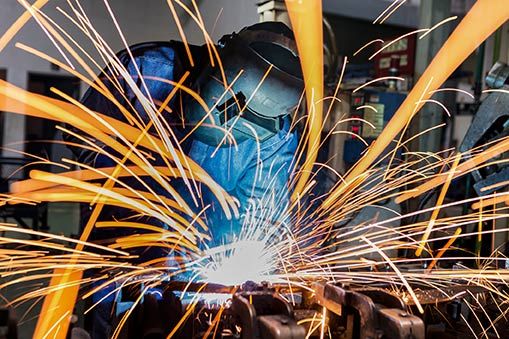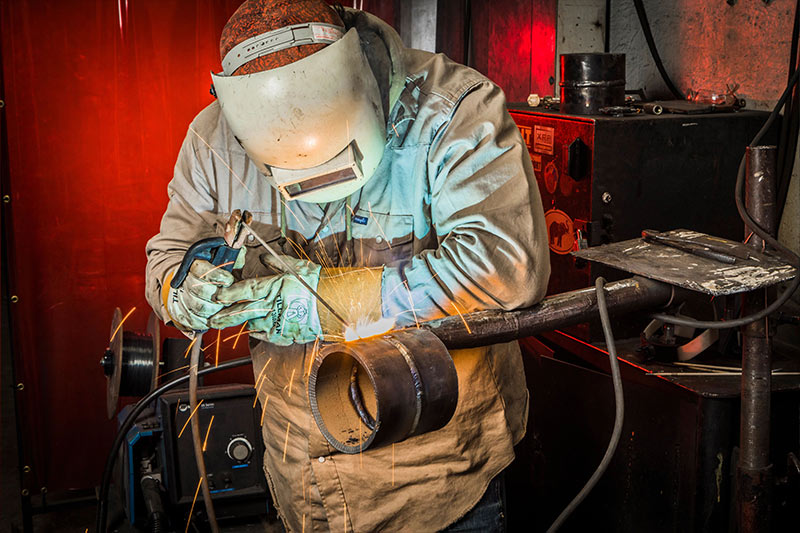Common Welding Repair Work Issues and Just How to Address Them Efficiently
Welding fixings typically come across a variety of problems that can jeopardize the honesty of the end product. Usual problems include poor penetration, porosity, and imbalance, to name a few. Each flaw provides one-of-a-kind difficulties that need particular methods for resolution. Comprehending these concerns is important for welders aiming to improve their skills and outcomes. This discussion will certainly discover these typical welding repair service issues and efficient methods to address them.
Poor Penetration
Inadequate infiltration takes place when the weld steel fails to totally fuse with the base material, resulting in weak joints and potential structural failures. This problem usually originates from insufficient warm input, inaccurate electrode angle, or incorrect welding speed. Welders may run into insufficient penetration as a result of a miscalculation of the essential criteria for a details material thickness or kind. In addition, contamination on the base material's surface can prevent reliable bonding, intensifying the trouble. To address insufficient penetration, welders need to guarantee ideal settings on their devices and keep a tidy work surface. Normal inspection of welds is recommended to identify any type of shortages early, enabling prompt improvements and the avoidance of jeopardized architectural integrity in bonded settings up.
Porosity
Porosity is an usual issue in bonded joints that materializes as tiny gas bubbles caught within the weld metal. This defect can jeopardize the honesty of the weld, causing lowered strength and prospective failing under tension. Belgrade. Porosity generally develops from contamination, moisture, or improper welding strategies, which allow gases to leave into the liquified weld swimming pool. To attend to porosity, welders must ensure appropriate surface area prep work, maintain a clean workplace, and make use of suitable welding specifications. Additionally, picking the right filler material and protecting gas can mitigate gas entrapment. Routine examination and screening of welds can assist determine porosity early, ensuring prompt restorative actions are taken, consequently protecting the quality and integrity of the bonded framework
Misalignment
Misalignment in welding can occur from numerous factors, consisting of improper arrangement and thermal expansion. Comprehending the origin causes is essential for effective resolution. Numerous modification techniques are readily available to realign components and assure architectural honesty.
Reasons for Imbalance
Welding misalignment typically stems from a variety of underlying problems that can compromise architectural stability. One key reason is incorrect fit-up of parts prior to welding, which can cause spaces and unequal surface areas. Variants in thermal development throughout the welding process can also result in distortion, specifically if the materials being signed up with have various coefficients of growth. Additionally, poor fixturing and clamping might fall short to hold elements firmly in position, leading to movement throughout welding. Badly maintained equipment, including welding machines and tools, might present incongruities in the weld bead, further adding to misalignment. Operator error, stemming from not enough training or experience, can likewise play a substantial role in developing misaligned welds.

Improvement Strategies Available
Dealing with misalignment properly needs a mix of corrective methods tailored to the specific problems at hand. One usual approach is the use of components or jigs to hold elements in the appropriate position throughout welding, making sure constant alignment. Furthermore, preheating the products can help in reducing distortion and enhance fit-up. For substantial misalignment, mechanical adjustment strategies, such as using hydraulic jacks or clamps, can be employed to correct the setting prior to welding. Post-weld heat treatment might also be needed to relieve tensions brought on by misalignment. Mindful examination and change during the configuration stage can avoid misalignment concerns from becoming substantial problems, advertising a smoother welding procedure and improving total structural stability.
Distortion
Distortion is a common obstacle in welding that can occur from different variables, including unequal heating and cooling. Recognizing the sources of distortion is essential for implementing efficient avoidance strategies. Addressing this concern not just boosts architectural honesty however likewise enhances the general high quality of the weld.
Sources of Distortion
When subjected to the extreme warmth of welding, products often go through modifications that can lead to distortion. This sensation mainly occurs from thermal growth and contraction throughout the welding process. As the weld location warms up, the product increases; upon cooling, it gets, which can produce internal tensions. On top of that, irregular home heating throughout a workpiece can intensify these stress and anxieties, causing warping or bending. The sort of material additionally plays a considerable function; steels with differing thermal conductivity and coefficients of growth might react in a different way, resulting in unpredictable distortions. Poor joint style and inadequate fixturing can add to misalignment throughout welding, boosting the probability of distortion. Comprehending these causes is essential for reliable welding fixing and prevention strategies.
Avoidance Techniques
Effective avoidance techniques for distortion during welding concentrate on controlling heat input and making certain proper joint style. Keeping a constant warmth input helps to lessen spot weld remover thermal development and tightening, which can result in distortion. Making use of techniques such as preheating the workpiece can also decrease the temperature level slope, advertising consistent heating. Furthermore, picking appropriate joint layouts, such as T-joints or lap joints, can enhance security and reduce stress and anxiety concentrations. Applying correct fixturing to protect the workpieces in area additionally aids in maintaining alignment during the welding process. Lastly, staggered welding series can disperse warmth a lot more equally, preventing local distortion. By using these techniques, welders can significantly lower the chance of distortion and improve the general high quality of their welds.
Splitting
Breaking is an usual issue experienced in welding repair work, typically resulting from various variables such as inappropriate air conditioning prices, material option, or poor joint preparation. The occurrence of cracks can greatly endanger the honesty of the weld, bring about prospective failures during procedure. To resolve this concern, welders have to first analyze the origin, making sure that materials are compatible and appropriately chosen for the particular application. Additionally, managing the air conditioning price during the welding process is essential; rapid cooling can generate stress and anxiety and cause cracking. Correct joint style and prep best mig welder for home use work also add to reducing the threat. Carrying out these techniques can improve weld quality and durability, eventually reducing the probability of fracturing in finished weldments.

Incomplete Fusion
A considerable issue in welding repair work is insufficient blend, which happens when the weld steel does not properly bond with the base product or previous weld passes - Montana Mobile Welding and Repair Belgrade Welding. This flaw can result in weaknesses in the joint, possibly visit the website endangering the stability of the bonded structure. Factors adding to insufficient combination include insufficient warmth input, improper welding method, and contamination of the surface areas being signed up with. To resolve this issue efficiently, welders must guarantee correct pre-weld cleansing and surface prep work, in addition to adjust their welding criteria to attain appropriate infiltration and combination. Normal evaluation throughout the welding procedure can likewise help determine insufficient fusion early, permitting for timely rehabilitative actions to improve the general top quality of the weld
Overheating
While welding repair services can boost structural stability, overheating provides a considerable obstacle that can result in material destruction. Excessive warm during welding can alter the mechanical residential or commercial properties of metals, resulting in decreased stamina, increased brittleness, and warping. This sensation is particularly important in high-stress applications where architectural reliability is critical. Determining getting too hot can entail aesthetic inspections for discoloration or distortion, in addition to monitoring temperature during the welding procedure. To minimize the risks related to overheating, welders ought to utilize ideal techniques, such as controlling warm input, adjusting travel speed, and utilizing ideal filler products. Furthermore, executing pre- and post-weld heat treatments can help bring back material homes and enhance the overall top quality of the repair work, making certain long-lasting efficiency and security.
Often Asked Inquiries
What Are the Typical Signs of a Welding Defect?

How Can I Check My Welds for Top quality?
To check welds for top quality, one can make use of aesthetic evaluations, ultrasonic screening, and radiographic approaches. Each method guarantees structural honesty, recognizes issues, and validates adherence to defined criteria, ultimately enhancing the integrity of the bonded joints.
What Safety Safety Measures Should I Take While Welding?
When welding, one need to focus on security by using suitable personal safety tools, guaranteeing appropriate air flow, securing flammable materials away, maintaining a tidy office, and understanding environments to prevent crashes and injuries.
Can I Fix a Weld Without Remodeling the Entire Joint?
Fixing a weld without renovating the whole joint is feasible, relying on the damages (Belgrade). Strategies such as grinding, including filler material, or utilizing a welding process can successfully attend to certain defects while preserving the surrounding framework
What Tools Are Essential for Effective Welding Repair Works?
Important tools for efficient welding repair work include a welding machine, cable brush, mill, safety gear, clamps, and filler materials. Each device plays an essential function in making certain quality and safety and security during the repair process. Porosity typically develops from contamination, wetness, or inappropriate welding strategies, which allow gases to escape into the liquified weld swimming pool. Badly kept equipment, consisting of welding makers and devices, might present variances in the weld grain, more contributing to imbalance. When subjected to the extreme warmth of welding, materials commonly undertake changes that can lead to distortion. Fracturing is an usual concern experienced in welding repair services, usually resulting from various aspects such as incorrect air conditioning prices, material option, or inadequate joint preparation. A considerable issue in welding repair work is insufficient combination, which takes place when the weld metal does not effectively bond with the base material or previous weld passes.